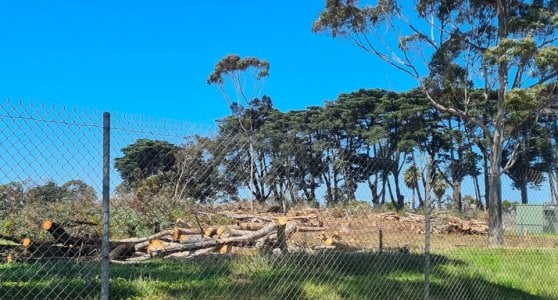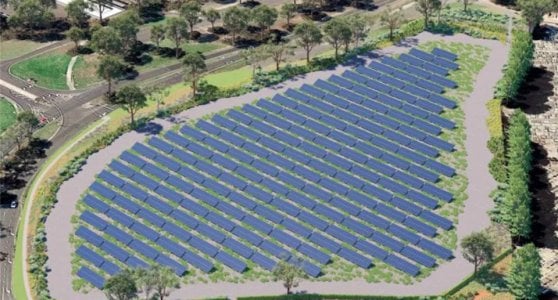Is this new ‘green’ energy project causing an uproar by destroying gum trees?
The green revolution continues to grow in Australia, but not everyone is happy with some of the renewable energy initiatives taking place.
Recent social media images showing mature native tree stumps at a cleared site in Victoria have led locals to question the environmental impact of a particular project.
A 3.8-hectare site populated with mature native trees was cleared at La Trobe University in Victoria for a solar energy project.
Photos revealing the remains of eucalyptus trees behind a fenced area were anonymously posted online, leading to significant reactions.
Social media users expressed concerns over carbon emissions resulting from tree removal.
Some online remarks included ‘Crazy logic’ and ‘Something seems off here’ while suggestions were made about placing the solar panels on rooftops or over car parks.
La Trobe University’s Bundoora Campus in northern Melbourne cleared an area to establish Victoria’s largest urban solar farm, which will consist of 4,300 panels and produce 2.9 megawatts of energy.
The clearing, which occurred during the bird breeding season, also raised concerns about the well-being of wildlife previously inhabiting the site.
Although La Trobe did not specify the types of fauna present, they confirmed that a zoologist had surveyed the area.
‘It was found that there was little indication of native fauna at the site, the zoologist captured and rehomed them to the nearest suitable habitat,’ it said.
La Trobe University also responded to concerns about the tree removal, stating that the trees lacked ‘special significance’.
Based on a biodiversity assessment, the university said the trees and vegetation on the site had ‘limited biodiversity value’, being ‘self-sown’ and infested with weeds.
While the exact number of mature trees removed remains undisclosed, La Trobe plans to plant over 600 trees and 40,000 plants to enhance the site’s biodiversity.
Earlier this year, the university stopped a plan by its building manager to fell a 400-year-old tree on campus.
La Trobe University aims for sustainability with a commitment to achieve carbon neutrality for its regional campuses by 2022 and the entire university by 2029.
Their Net Zero program emphasises a secure, cost-effective energy supply while prioritising community benefits and preparing for future university transformations.
This initiative will introduce an energy analytics platform called LEAP, serving as a ‘Living Lab’ and positioning La Trobe as a sustainability leader.
This effort is backed by a $75 million investment, funding various projects to reach their objectives.
Video source: YouTube/La Trobe University

Members, what do you think of this story? Let us know your thoughts in the comments below!
Recent social media images showing mature native tree stumps at a cleared site in Victoria have led locals to question the environmental impact of a particular project.
A 3.8-hectare site populated with mature native trees was cleared at La Trobe University in Victoria for a solar energy project.
Photos revealing the remains of eucalyptus trees behind a fenced area were anonymously posted online, leading to significant reactions.
Social media users expressed concerns over carbon emissions resulting from tree removal.
Some online remarks included ‘Crazy logic’ and ‘Something seems off here’ while suggestions were made about placing the solar panels on rooftops or over car parks.
La Trobe University’s Bundoora Campus in northern Melbourne cleared an area to establish Victoria’s largest urban solar farm, which will consist of 4,300 panels and produce 2.9 megawatts of energy.
The clearing, which occurred during the bird breeding season, also raised concerns about the well-being of wildlife previously inhabiting the site.
Although La Trobe did not specify the types of fauna present, they confirmed that a zoologist had surveyed the area.
‘It was found that there was little indication of native fauna at the site, the zoologist captured and rehomed them to the nearest suitable habitat,’ it said.
La Trobe University also responded to concerns about the tree removal, stating that the trees lacked ‘special significance’.
Based on a biodiversity assessment, the university said the trees and vegetation on the site had ‘limited biodiversity value’, being ‘self-sown’ and infested with weeds.
While the exact number of mature trees removed remains undisclosed, La Trobe plans to plant over 600 trees and 40,000 plants to enhance the site’s biodiversity.
Earlier this year, the university stopped a plan by its building manager to fell a 400-year-old tree on campus.
La Trobe University aims for sustainability with a commitment to achieve carbon neutrality for its regional campuses by 2022 and the entire university by 2029.
Their Net Zero program emphasises a secure, cost-effective energy supply while prioritising community benefits and preparing for future university transformations.
This initiative will introduce an energy analytics platform called LEAP, serving as a ‘Living Lab’ and positioning La Trobe as a sustainability leader.
This effort is backed by a $75 million investment, funding various projects to reach their objectives.
Video source: YouTube/La Trobe University
Key Takeaways
- Mature eucalyptus trees across a 3.8-hectare site at La Trobe University's Bundoora Campus have been cleared to create Victoria's largest urban solar farm, causing a stir on social media.
- Concerns were raised about the timing of the clearing during bird breeding season and the welfare of wildlife, and questions were asked about why solar panels hadn't been installed on rooftops or over car parks instead.
- The university said the site held little biodiversity value, and that a zoologist was hired to survey and rehome any displaced fauna.
- This comes after La Trobe University was involved in a previous tree-related controversy earlier this year when they axed a plan to chop down a 400-year-old tree on the campus.










